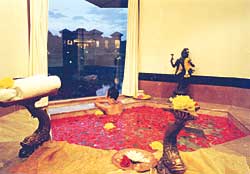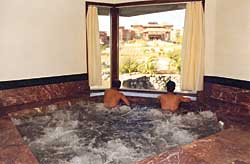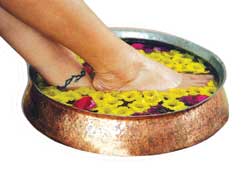 Dim lights, soothing music, an inviting bed, gentle aromas and a smiling attendant. Robed in a comfortable gown, the guest is ushered onto the bed, instructed to lie down and relax. A mixture of pleasant-smelling oils is poured into strong, firm hands that gently knead their way around the knees. They slip down the calves while working the muscles, and gently but firmly, toe-by-toe, joint-by-joint, massage the nerve points on the feet.
Dim lights, soothing music, an inviting bed, gentle aromas and a smiling attendant. Robed in a comfortable gown, the guest is ushered onto the bed, instructed to lie down and relax. A mixture of pleasant-smelling oils is poured into strong, firm hands that gently knead their way around the knees. They slip down the calves while working the muscles, and gently but firmly, toe-by-toe, joint-by-joint, massage the nerve points on the feet. You don't have to go to Thailand to get any of this, or to the fancy new Ananda Spa near Rishikesh in the Garhwal Himalaya. There are spas and spa treatments to be had in Nepal, in Kathmandu and Pokhara.

The massage at the Hyatt's Club Oasis is sheer indulgence. Half an hour later, and Rs 850 lighter, the guest heads to the steam bath for 15 minutes before stepping into the jacuzzi. A rejuvenated, glowing person leaves the hotel.
Spas, those old standbys of Dickens and Thackeray novels, were once synonymous with 'taking the waters' at springs with minerals or other curative natural resources. Even today, many spas are based on long-term treatments and often used to recover from stress, long-term illnesses or to receive cures for specific health problems. But that is time-consuming, while also on the rise is the number of people who are simply burnt-out, and just want some pampering. The new-generation spas offer luxurious surroundings and exotic treatments, often in connection with a hotel or a resort.
In Nepal, the concept's catching on. An increasing number of hotels are offering facilities designed to entice jet-setting executives and travel-weary tourists. "Most enquiries regarding the Fulbari resort are accompanied by enquiries about the spa, which opened about three years ago," says Ramesh Rawat, a sales official with the Spa Avatar at the Fulbari in Pokhara. "Most of our in-house guests use it, and many people visit from Kathmandu, too." At the Fulbari, Nepal's first international-standard spa, guests are offered treatments and packages ranging from aromatherapy with exotic Himalayan incenses for the world-weary, to a combination of deep-cleansing facials and specially-tailored massages for avid trekkers just back from a rugged trek around the Annapurna. Aptly named after the Sanskrit word meaning reincarnation, rebirth, renaissance, revival and rejuvenation, the Fulbari Spa Avatar works with guests to ensure they get the best combination of massages, facials, body masques and complementary therapies such as reflexology, ranging from $ 20-$130 for singles and from $32-$209 for couples.
The whimsically-named Annapurna Adventure package includes an aromatic steam bath, followed by a stimulating cleansing and anti-oxidant treatment with body stimulating polish. Then comes an energising body masque and deep tissue sports massage to ease tired joints and sore muscles. You then fall asleep in the Jacuzzi, and emerge to a deep-cleansing, purifying facial. The cost for four hours: $122 for a single person, and $195 for a couple. The Exotic Himalayan Discovery sees a guest spend 15 minutes in the herbal steam room. An aromatic Himalayan Honey Seed Rub is followed by a dip in an aromatic jacuzzi, and a "Himalayan Massage" and rounded off with a facial using Himalayan herbs.
Nearer here in the Valley, the Royal Hana Garden on Lazimpat ensures that you don't have to travel to Tatopani. The restaurant's Japanese-style outdoor tub has a constant flow of warm, calming water, and holds two people at a time. After half-an-hour of soaking in it, the last thing you want to do is leave.
 Also available soon will be the spa at the luxurious Le Meridien Gokarna. "In the modern world," explains Samira Wadi, manager of the Le Meridien Gokarna, "it is difficult to find the time and space to pamper oneself, but there is a growing awareness of the necessity of fitness. Personal wellness, such as a rejuvenating massage aren't only physical pleasures they're also mentally reviving, a recharge of our batteries." Le Meridien Kathmandu Gokarna Forest Resort Spa's USP will be its traditional ayurvedic treatments, adapted for the leisure market. There will be the usual variety of relaxing massages and general fitness and diet development programs, but the resident ayurvedic doctor will also take on ailments such as arthritis, spondilytis, paralysis, obesity, sinusitis, and migraine headaches.
Also available soon will be the spa at the luxurious Le Meridien Gokarna. "In the modern world," explains Samira Wadi, manager of the Le Meridien Gokarna, "it is difficult to find the time and space to pamper oneself, but there is a growing awareness of the necessity of fitness. Personal wellness, such as a rejuvenating massage aren't only physical pleasures they're also mentally reviving, a recharge of our batteries." Le Meridien Kathmandu Gokarna Forest Resort Spa's USP will be its traditional ayurvedic treatments, adapted for the leisure market. There will be the usual variety of relaxing massages and general fitness and diet development programs, but the resident ayurvedic doctor will also take on ailments such as arthritis, spondilytis, paralysis, obesity, sinusitis, and migraine headaches. Other options at the Le Meridien include aromatherapy, reflexology, and other pure treatment based on European, Indonesian or Thai traditions. The spa's treatment products will be tested in-house before being used, and there are plans to also start a spa boutique to retail Le Meridien Kathmandu Gokarna Forest Spa-branded products such as massage oils, incenses, aromatic oils and oil burners, bathrobes, towels, soaps, lotions, herbal teas and the like. In addition, the special juice bar and healthy food menu will be offered to all spa guests, as well as meditation courses, healthy eating sessions, massage therapy training and yoga classes
Ayurveda in three words
Ayurveda, or the 'science of life', aims to prevent illness in the healthy, and cure disease in the ailing. The science works on the notion that the body is governed by three functioning principles, or tridosas.
Vatta: Phenomena that come under the rubric of the Central and Sympathetic Nervous Systems.
Pitta: The functions of heat production and metabolism, such as digestion, the circulatory system and the various secretions and excretions that are either the means or the ends of tissue combustion.
Kapha: The functions of heat regulation and secondary formation of various preservative fluids such as mucus, synovial fluid etc.
The tridosas have their own definite Pramana (quantity), Guna (quality) and Karma (function). In a normal form they attend to different functions of the body and maintain it.
 The scent of content
The scent of content The healing, cleaning, preservative and mood-enhancing properties of natural plant oils have been recognised for over 6,000 years. Stress, pollution, unhealthy diet, hectic, yet sedentary lifestyles-all these factors have adverse effects on our bodies and spirits. The art of aromatherapy harnesses the pure essences of aromatic plants, flowers and resins, to work on the most powerful of the senses-smell and touch - to restore the harmony of body and mind. Essential oils can be used to treat common ailments, and promote good health and emotional well-being.
Essential oils can be burnt, or applied to the body. Before you choose an essential oil for massage purposes, you need to identify a carrier oil. Choosing the appropriate carrier oil adds considerably to the dynamic nature of an aromatherapy massage and can have specific benefits, such as helping to guard against heart disease or inflammatory diseases such as arthritis.
Almond oil is a good source of vitamin D and suitable for all skin types, especially dry or irritated skin.
Avocado oil is easily absorbed into the deep tissues and so is excellent for mature skin. It can help to relieve the dryness and itching of psoriasis and eczema.
Jojoba oil is rich in vitamin E, and good for sensitive or oily complexions. It contains bactericidal properties, making it useful oil for the treatment of acne.
Sesame oil, when made from untoasted seeds, sesame oil is good for skin conditions, and can be used as a sun-screen.
Olive oil is too sticky for massage, but a good addition to a blend for mature or dry skin.
There are many essential oils in use, but some are more popular than others.
Geranium The rose-scented geranium has useful properties, including its ability to bring a blend together for a more harmonious scent. Geranium has an antidepressant quality, and is good for nervous tension, exhaustion, and circulatory and skin problems.
Lavender is one of the safest and most versatile of all essential oils. For centuries it has been used as a refreshing fragrance and as a remedy for stress-related ailments. It is especially helpful for tension headaches and nervous digestive upsets.
Neroli is uplifting and calming. It is useful during times of anxiety, panic, hysteria, shock and fear. It can help promote self-esteem and is particularly effective for nervous diarrhoea and other stress-related conditions.
Rose evokes a general sense of pleasure and happiness. It is sedating and anti-inflammatory. Rose oil has a wide reputation as an aphrodisiac, and where anxiety is a factor, it can be very beneficial.
Sandalwood Probably the oldest perfume in history, sandalwood has been used for over 4,000 years. It has a relaxing, antidepressant effect, and where depression causes sexual problems, sandalwood can be an aphrodisiac.
Ylang ylang is an intensely sweet essential oil that sedates and eases symptoms of excessive tension, such as insomnia, panic attacks, anxiety and depression.
Henna is a somewhat uncommon Indian oil, often distilled with sandalwood as an attar. It is excellent for devotion, and to open up psychic abilities. The herb itself is used to dye hair and make it stronger.
Saffron helps balance the nervous system, and promotes digestion and quietness of the mind. It also rejuvenates all tissues of the body.
Get to the point
Much eastern medicine believes that the body runs on a kind of 'vital energy', imbalances in which cause illness. In forms of Indian medicines this is called prana, and in Chinese and Japanese medicine, chi, or qi. This energy is said to run to every part of the blood, and is carried to and from the heart in veins and arteries. The movement of qi can be affected by massaging an acupressure point on a meridian line, or by inserting an acupuncture needle a few millimetres in, or by burning moxa herbs on the appropriate point. Working on the right spot can free trapped chi, slow it down if it is moving too fast or encourage it into an area that it has been bypassing.
Reflexology works with a different map that divides the body into 10 vertical zones, starting from the top of the head, branching out to end in the 10 fingers, with the main branches ending in the toes. According to this system, each part of the body is represented by a reflex point on the foot or the hand. Like acupressure, the aim of reflexology is to help the body's energy circulate effectively without blockages, energy loss or stagnation. Reflexology has been found useful for stress-related conditions such as allergies, asthma, insomnia, depression, anxiety and migraine; disorders caused by muscle tension such as back pain and fibrosis; and women's conditions such as PMS, pregnancy, childbirth and menopause. It is said to have eased the symptoms of chronic fatigue syndrome (CFS), multiple sclerosis and even cancer.


